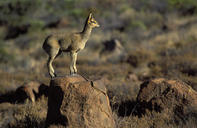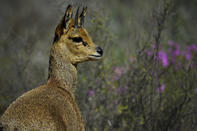
Name
Klipspringer (Oreotragus oreotragus)
The Klipspringer gets its name from the Afrikaans for ‘rock jumper’ which describes the animal’s ability to move freely in rocky territory, seemingly on tiptoe.
Appearance
The klipspringer of South Africa weighs 11-13 kg and stands 500-600 mm high at the shoulder. This antelope has a small, and stocky build, with round ears placed at the far back of the head that have prominent dark inner markings. Their coats have a coarse texture and come in shades of grey, yellow, brown and red with a white underbelly.
They have large black preorbital glands with white patches found around the chin and mouth areas. The female klipspringer is slightly larger than the male. Males have short horns that are ringed at the base.
Hollow Fur

A klipspringer’s fur is hollow and each strand is flattened and springy. This provides the device for thermoregulation in the otherwise exposed and harsh environment where klipspringer reside. Rocky areas can be both exceptionally cold and very hot.
The unique pelage (fur coat) insulates the body from these temperature extremes and helps to conserve moisture. It protects the klipspringer from heat loss by trapping body-warmed air amongst the coat while the flatness and looseness of the individual hairs allow for increased heat reflection and loss when it’s hot.
The coat also provides protection should the klipspringer fall on the rocks with the hollow-filled hairs acting as miniature shock-absorbers. Historically klipspringer hair was used to stuff saddles and to make numnahs or saddle cloths. By Megan Emmett
Predators
The klipspringer is preyed upon by most big predators found in South Africa. These include lions, leopard, jackals and the spotted hyena. The klipspringer calves are vulnerable to big eagles and baboons due to their small size. The klipspringers are always on the alert for predators, as they have to forage far from their shelters.
They are always aware of alarm calls made by other animals and react to danger by running to higher ground with the female in the lead. Once the klipspringers are safe, they send alarm calls out in duets.
Klipspringer Diet
The klipspringer rarely feeds on grass. They prefer to browse on a variety of shrubs, flowers, shoots and fruits found out in the wild of South Africa. They are not dependent on water.Klipspringer Breeding
Lambs are born during the spring and summer months in South Africa, after a gestation period of six months. The klipspringer young reaches maturity at one year old, after which they are expelled from the group. A single young is born anytime during the year after a gestation period of 7 months.Klipspringer Behaviour
The klipspringer lives in groups of about eight individuals, with males and females forming lasting bonds. Klipspringers are territorial and strongly defend their permanent territories in South Africa.Klipspringer Habitat
klipspringers are limited to the rocky, mountainous areas of South Africa. This environment makes it easy for the light-footed klipspringer to escape from predators. klipspringers are located in the Zoutpansberg and Lebombo Mountain ranges and foothills, along the Kuiseb River in the Namib Desert, lower Orange River in South Africa.
They are also found in the mountains of the Western Cape. They are rarely found in the Drakensberg Mountain Range.
 Klipspringer will defend their isolated resources by chasing intruders away but are seldom aggressive to one another and the presence of an ...
Klipspringer will defend their isolated resources by chasing intruders away but are seldom aggressive to one another and the presence of an ... ‘Klip’ means rock and ‘springer’ means jumper in Afrikaans and they are descriptive of this antelope’s rocky habitat and its excep...
‘Klip’ means rock and ‘springer’ means jumper in Afrikaans and they are descriptive of this antelope’s rocky habitat and its excep... Learning about the mammals of South Africa is now so much easier for all South Africans - SouthAfrica.co.za is an excellent source of inform...
Learning about the mammals of South Africa is now so much easier for all South Africans - SouthAfrica.co.za is an excellent source of inform...